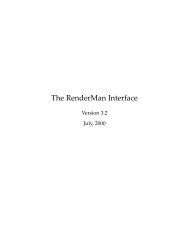Controlling Fluid Simulations with Custom Fields in Houdini Master ...
Controlling Fluid Simulations with Custom Fields in Houdini Master ...
Controlling Fluid Simulations with Custom Fields in Houdini Master ...
Create successful ePaper yourself
Turn your PDF publications into a flip-book with our unique Google optimized e-Paper software.
Figure 20: The purple eld represents the fuel, the yellow eld is the burn andthe white eld is the density result<strong>in</strong>g from the combustion <strong>in</strong> the fuel fromcurve example.the tree where the branches are thicker, the animated geometry <strong>with</strong> the spread<strong>in</strong>gattribute is then baked to disk to speed up the rest of the network. Thisattribute is then transferred us<strong>in</strong>g the volume transfer tool. The temperatureeld is the same as the fuel eld. The tree geometry came <strong>with</strong> po<strong>in</strong>t velocitieson it but those could alternatively be calculated <strong>with</strong> a trail sop as the topologydoes not change over time. These velocities are also transferred <strong>in</strong>to a customeld.In DOPS those three custom elds are brought <strong>in</strong> <strong>with</strong> Sop Scalar/Vectorelds and their SOP path and Time ($T) parameters are set to Always evaluate.Dur<strong>in</strong>g the simulation step the elds are added to their respective target eldsus<strong>in</strong>g Gas Calculate microsolvers. The fuel eld is not added <strong>with</strong> a maximumoperation as this added too much fuel <strong>in</strong>to the simulation which resulted <strong>in</strong> amassive explosive reaction, so <strong>in</strong>stead it is copied every frame and overwritesthe old fuel data from the previous frame. A Gas Dissipate is also added toslowly dissipate the density. The various stages can be seen <strong>in</strong> Figure (21).Fuel from particles In this example a simple terra<strong>in</strong> is modeled and particlesfall down from above the terra<strong>in</strong> and collide <strong>with</strong> it. A particle that is collid<strong>in</strong>gis added to a collision group. Outside of the particle network <strong>in</strong> sops, the po<strong>in</strong>tsthat are not <strong>in</strong> the collision group are deleted. The amount of collisions caneasily be <strong>in</strong>creased or decreased depend<strong>in</strong>g on the birthrate parameter of thesource pop <strong>in</strong>side the pop network. At each frame there are generally betweenone and three particles <strong>in</strong> the collision group. By us<strong>in</strong>g an attribute transfer,the normal from the collision surface is transferred to the particle. Now thevolume attribute transfer tool is used to dene the fuel and temperature eldsbased upon the metaball density. A custom velocity eld will also be generated<strong>with</strong> the tool, us<strong>in</strong>g the normal attribute from the particles which has just beentransferred from the surface.30















